 |
Mustang Sally
|
 |
||||||||
|
||||||||||
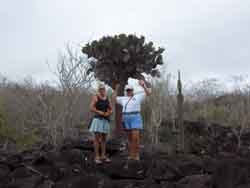
We sailed from Bahia del Caraquez, Ecuador for Wreck Bay, Galapagos Islands on June 17th, 2006. The 5 day passage was notable for the brisk sailing and the huge south Pacific swells we encountered. We arrived in the Galapagos on the morning of June 22nd. Pictured on the left Sharon and Catherine celebrate completion of the passage and our safe arrival.
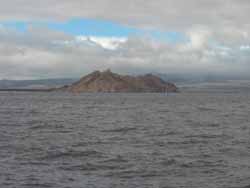 The picture
on the right shows our landfall approaching Isla Cristobal. The
rock shown at the left below is called "Kicker Rock" and is a terrific scuba
diving site. The rock is 600 feet high and is split in half with
the dive site running right through the rock.
The picture
on the right shows our landfall approaching Isla Cristobal. The
rock shown at the left below is called "Kicker Rock" and is a terrific scuba
diving site. The rock is 600 feet high and is split in half with
the dive site running right through the rock.
 The Galapagos Islands were made famous by Charles Darwin, who used
the unique plant and animal life to support his theories of evolution
and natural selection. The Galapagos Islands were know to the Inca
and the early Spanish explorers. The islands are very
lightly populated. The first permanent
settlements on the island were established at the start of the twentieth century.
The Galapagos Islands were made famous by Charles Darwin, who used
the unique plant and animal life to support his theories of evolution
and natural selection. The Galapagos Islands were know to the Inca
and the early Spanish explorers. The islands are very
lightly populated. The first permanent
settlements on the island were established at the start of the twentieth century.
The Islands were a natural provisioning stop in previous centuries for sailing ships. The lush animal and plant life could be easily harvested. The giant Galapagos turtles were particularly easy prey and tens of thousands were taken for sailor's dinners.
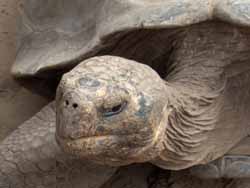 Although the Islands are on the equator, they are cooled by the
Humboldt ocean current, which flows from the Antarctic, north up the
coast of South America, then west around the Galapagos and into the
Pacific. The islands were often cloudy, but it was always nice
and warm, not sizzling hot, just very pleasant. The water was very
clear and refreshingly brisk. Scuba diving was par excellent.
Although the Islands are on the equator, they are cooled by the
Humboldt ocean current, which flows from the Antarctic, north up the
coast of South America, then west around the Galapagos and into the
Pacific. The islands were often cloudy, but it was always nice
and warm, not sizzling hot, just very pleasant. The water was very
clear and refreshingly brisk. Scuba diving was par excellent.
Our stay in the Islands involved a little, how shall we say - bending of the rules. The Ecuadorian's are very serious about the somewhat contrary goals of protecting the islands as a UN designated 'World Heritage Site' and exploiting the islands via tourism. The rigors of obtaining all the permits, visas and clearances has been known to take up to eight weeks for visiting boats. Not having that kind of patience, we ignored the permitting issue and just showed up.
When asked by Galapagos officialdom for our permits, we claimed we were on our way to the Marqueses and had equipment problems with the boat. "No problem they said, here is a ten day visa." Later when we visited another island, we were granted an extension. The Ecuadorian government tries to tightly control boats and tourism, but the reality is that the Galapagos are a long way from the Ecuadorian capital of Quito and many local officials want to encourage visitors.
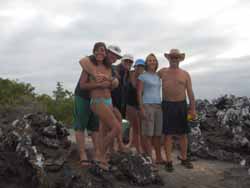
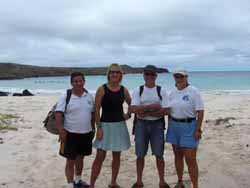 We hung out with an old acquaintance, who became a new friend.
Filipe, who sails the boat Renegade, was based in our home port of
Semiahmoo. He is pictured on the left between Catherine and
Sharon, our guide, Carlos on the left. We also ran into American amigos from the boat
Bogtrotter. Pictured at the right, (left to right) Tim, Cindy,
Sharon, Ann, Catherine and Rae . Together these bands of
desperados shredded the Galapagos.
We hung out with an old acquaintance, who became a new friend.
Filipe, who sails the boat Renegade, was based in our home port of
Semiahmoo. He is pictured on the left between Catherine and
Sharon, our guide, Carlos on the left. We also ran into American amigos from the boat
Bogtrotter. Pictured at the right, (left to right) Tim, Cindy,
Sharon, Ann, Catherine and Rae . Together these bands of
desperados shredded the Galapagos.
While on the subject of people, the Galapagonians are wonderful. Genuine, friendly and helpful they were always there with a smile and a helping hand. They would go miles out of their way to try and make you feel welcome and at home. Many are looking for business, but they do it in the most honest and up-front way that you can not help but like them. Sadly, the AIDS infection rate in the Islands small population is said to be over 25%. That is a little too friendly!
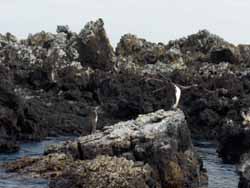 In
the following text you can click on any of the highlighted words to view a
slide show. Click any of
the pictures for a zoomed view.
In
the following text you can click on any of the highlighted words to view a
slide show. Click any of
the pictures for a zoomed view.
Both the islands we toured,
Isla Cristobal and
Isla Isabela are
delightful. The eco-systems are diverse by altitude. Dry and
desert like on the coasts, and increasingly lush as one travels uphill.
One of the main attractions are the
Galapagos - i.e. the giant land
turtles that the islands are named after. Galapagos is
a word for turtle in Spanish. Then there are the
giant iguanas,
amazing creatures. We also saw white tipped reef
sharks,
penguins
and pink flamingos.

Catherine had never been around seals before and it was fun to play around the friendly seals. The seals were so friendly, one climbed up on Mustang Sally. We awoke one morning to a seal looking down the hatch at us in our bunk. Another time a seal made itself at home in our cockpit, curling up for a nap in the blankets we leave on deck. Sealing Sally's perimeter to the seals was a challenge.
Scuba diving at Kicker Rock was killer. Sixty foot visibility, sharks, rays and terrific support from the dive company After the dive, we snorkeled a lovely bay where the friendly sea lions come out to play. They nip at you like a playful dog might - so you have to be careful, but they mean no harm. One of our dive company had his hair bit, and our dive master was sporting scars from a few bites.
All the Galapagos animals seem fearless of man and one can get very close. The Galapagos are also a great place to relax, hang out and enjoy life. Terrific beaches, lots of simple hotels and hostels, low cost of living and eco-systems that blow your socks off.
Galapagos is a naturalist wonderland and the two weeks we spent there could easily have stretched to a month or two. But Polynesia beckoned with the challenge of crossing the big blue Pacific. The Galapagos Islands are a hauntingly beautiful and unique place on this earth. True nature lovers should not miss it. Click here for a Galapagos Adios.
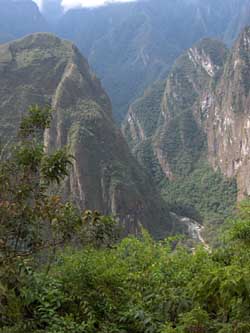
We were thrilled with our three week inland trip to Peru. From May 22nd to June 10th 2006, we bused, flew, and taxied our way through Peru. That country is BIG. We sailed on a reed boat, we stood on a floating island. We hitch hiked and we walked. We hiked the mountains of Machu Pichu! We saw allot of Peru, but the country is so big and diverse that there is much more that could be seen. To see all of Peru could take many months. To know it all would take a lifetime.
Peru is a huge diverse country with treasures that rival any in this world. Peru's cultures span 4,000 years!
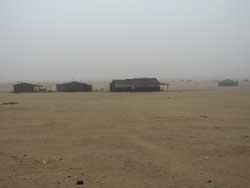 Contrast
abound. Desert to rain forest, sea side to mountains,
sophisticated to backwoods, Pagan to Christian. We traveled 5500 miles
to touch Peru's treasures. Peru showed and taught us many things.
Contrast
abound. Desert to rain forest, sea side to mountains,
sophisticated to backwoods, Pagan to Christian. We traveled 5500 miles
to touch Peru's treasures. Peru showed and taught us many things.
Things like the abrupt change from tropical green garden like Ecuador to
Peru's desert west coast. The picture on the right illustrates the
bleakness of the west coast. The coastal desert spans the entire
county from near the northern frontier to and beyond the southern border
with Chile.
The desert oases. Fed by irrigation, turning the desert landscape green.
The dusty Altiplano. The lush tropical interior. Where ever we went in
Peru were struck by the diversity of this great South American country.
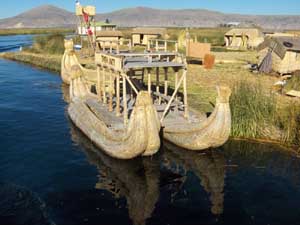
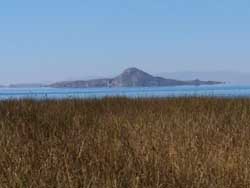 High
in the Andes, in southern Peru, Lake Titiqaqa is a fresh water sea. On
its shores is the city of Puno - the birth place of the Inca. The lake
near Puno is dotted with dozens of man made islands. The Inca
people construct the Islands from reeds. We were astounded. We walked on
the reed islands and sailed on Inca reed boats. Click
here to check out
the floating islands.
High
in the Andes, in southern Peru, Lake Titiqaqa is a fresh water sea. On
its shores is the city of Puno - the birth place of the Inca. The lake
near Puno is dotted with dozens of man made islands. The Inca
people construct the Islands from reeds. We were astounded. We walked on
the reed islands and sailed on Inca reed boats. Click
here to check out
the floating islands.
This is where Thor Hyderdal got his inspiration for building Ra I and
Ra II with which he proved that ancient peoples could have crossed
oceans in boats built of reeds. Many of Hyderdal's theories have
fallen out of favor, but he was a great twentieth scientist/adventurer.
Read his books!
After the tropic's, Puno with it's 12 thousand foot altitude has cold
cold June nights. Standard local dress was ski jacket, toque and gloves.
Go to a restaurant or hotel - you can leave your hat on! Even your
waiter will be in a ski jacket. The people of Puno have not implemented
indoor heating. Click here for
a slide show of Puno.
 The
Island of Tequila on Lake Titiqaqa was particularly interesting. The
Inca there live as they did in the past. A communal island of six
communities, with no police needed or wanted. The local traditional laws
are simple: 1) No stealing, 2) No lying 3) No laziness. After that, what
else does one need? Click
here for a look at the Island of Tequila.
The
Island of Tequila on Lake Titiqaqa was particularly interesting. The
Inca there live as they did in the past. A communal island of six
communities, with no police needed or wanted. The local traditional laws
are simple: 1) No stealing, 2) No lying 3) No laziness. After that, what
else does one need? Click
here for a look at the Island of Tequila.
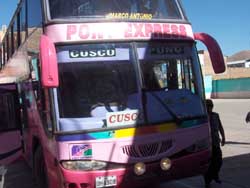 The
Peruvian's have a huge fleet of large comfortable two story buses as
well as thousands of regular highway buses. We were nearly always able
to get upstairs front window seating. This gave us a birds eye view as
we traveled. We spend better than 60 hours on buses in our first week in
Peru. Even with the almost horizontally reclining seats and foot rests,
one's butt begins to protest. Jets were more comfortable for the return
journey.
The
Peruvian's have a huge fleet of large comfortable two story buses as
well as thousands of regular highway buses. We were nearly always able
to get upstairs front window seating. This gave us a birds eye view as
we traveled. We spend better than 60 hours on buses in our first week in
Peru. Even with the almost horizontally reclining seats and foot rests,
one's butt begins to protest. Jets were more comfortable for the return
journey.
Altitude sickness was a problem for us. Puno, at just better than 12,000
feet challenged us to adapt. After 3 days of complete rest, Sharon was OK and Rae's symptoms
began to subsided. But altitude sickness continued to dog Rae throughout the high
Andes.
 The
city of Cusco is a delight. In previous centuries this was the
center of the Inca Empire and later a Spanish administration and
religious headquarters. Spain's efforts to to covert and subject the
Incas' were powerful, but Inca pride is strong, growing and breaking the
remaining chains that bind. Today Cusco is a modern day capital of
the province of Cusco and a booming tourist center. Click
here to view some Cuso scenes.
The
city of Cusco is a delight. In previous centuries this was the
center of the Inca Empire and later a Spanish administration and
religious headquarters. Spain's efforts to to covert and subject the
Incas' were powerful, but Inca pride is strong, growing and breaking the
remaining chains that bind. Today Cusco is a modern day capital of
the province of Cusco and a booming tourist center. Click
here to view some Cuso scenes.
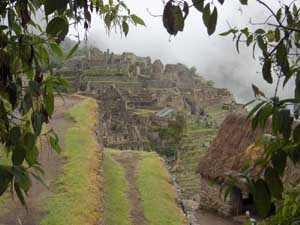 Machu
Pichu, Machu Pichu, Machi Pichu. What a challenge to describe - an
enigma - beautiful beyond belief. You experience constant vertigo as
your mind refuses to believe the larger than life sight of the mountain
top city and the huge vertical drops. Inca stone paths, stairs and
ladders connect the city to outlying sites and the outside world. Most
everywhere you go you are only a few steps away from hundred or thousand
foot drops. Why did they build it?
Machu
Pichu, Machu Pichu, Machi Pichu. What a challenge to describe - an
enigma - beautiful beyond belief. You experience constant vertigo as
your mind refuses to believe the larger than life sight of the mountain
top city and the huge vertical drops. Inca stone paths, stairs and
ladders connect the city to outlying sites and the outside world. Most
everywhere you go you are only a few steps away from hundred or thousand
foot drops. Why did they build it?
Some sources say Machu Pichu was an Inca university. A place of
literally "higher" learning. Here candidates to become the Grand Inca
studied and competed for their calling. Machu Pichu has to be the most beautiful, mysterious and interesting man
made place in the world. The slide show is a little long but it
had to be to even come close to giving you a taste of that place. Have a look at Machu Pichu by clicking
here. Let us
know what you think of it.
After visiting the most beautiful place in the world we returned to
Bahia Caraquez to boring old boat maintenance and preparations for the
Galapagos and south Pacific voyages.
In the Galapagos, perhaps, just maybe, the pure natural beauty will
compare favorably with Machu Pichu.
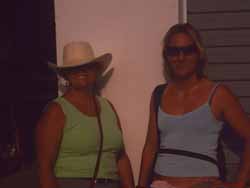 We
landed on the South American continent at Bahia del Caraquez, Ecuador
on Monday May 15th 2006. It was a 7 day upwind and up-current
voyage from Panama City. As usual, weather predictions of light winds
and easy ocean current proved wrong. Nevertheless it was a pretty easy
passage. Made easier by our crew Catherine MacTaggert, pictured at
right with Sharon. She
helped sail the boat and lightened the load.
We
landed on the South American continent at Bahia del Caraquez, Ecuador
on Monday May 15th 2006. It was a 7 day upwind and up-current
voyage from Panama City. As usual, weather predictions of light winds
and easy ocean current proved wrong. Nevertheless it was a pretty easy
passage. Made easier by our crew Catherine MacTaggert, pictured at
right with Sharon. She
helped sail the boat and lightened the load.A fun part was the hazing ceremony for the equator crossing. Rae dressed up like King Neptune and converted everyone from slimy Polywogs to equator crossing Shellbacks. Ours was quite a mild ceremony compared to some of the old navy standards. Apparently, in the old days, beatings, keelhauling, and pelting the Polywogs with fruit was the norm. Fatalities were not uncommon. Uncivilized behavior unbecoming of the sophisticated crew crew on Mustangs Sally. We just covered the Polywogs with whipped cream and sea water. Poured some champagne in the sea for Neptune and drank the rest. We are all SHELLBACKS now.
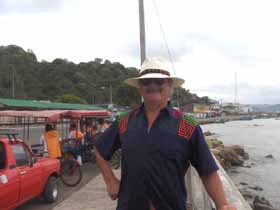 Bahia del
Caraquez is a resort town where the well to do of Ecuador come for
vacations and long weekends. The town is pretty quiet now as this is off
season. Rainy season is just over and now they have a month or three of
cloudy weather between the wet and dry seasons. Kind of like southern
California in the summer. Sea haze, sometimes burning off in the day. I
am glad for the shady days after nearly a year in never ending sunshine.
Temperatures are is still in high 20s - low 30s Celsius.
Bahia del
Caraquez is a resort town where the well to do of Ecuador come for
vacations and long weekends. The town is pretty quiet now as this is off
season. Rainy season is just over and now they have a month or three of
cloudy weather between the wet and dry seasons. Kind of like southern
California in the summer. Sea haze, sometimes burning off in the day. I
am glad for the shady days after nearly a year in never ending sunshine.
Temperatures are is still in high 20s - low 30s Celsius.
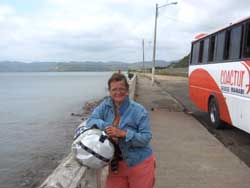 A gentleman
from the United States by the name of Trip has built a little nirvana
here. His nirvana has the intriguing name of Bahia Amestad.
It is a beautiful yacht club and cruiser hang out. Trip invited
us to consider his facilities home. He and his lovely wife Maji serve up the
best food that we came across in South America. The facilities are
exquisite.
A gentleman
from the United States by the name of Trip has built a little nirvana
here. His nirvana has the intriguing name of Bahia Amestad.
It is a beautiful yacht club and cruiser hang out. Trip invited
us to consider his facilities home. He and his lovely wife Maji serve up the
best food that we came across in South America. The facilities are
exquisite.
The people of Bahia del Caraquez are, by and large, happy, friendly and helpful. The town is like small town Canada. Most locals are curious and grateful for the people who come in boats to spend time and money in their piece of paradise. Theft is almost unknown in Bahia del Caraquez and there is little need to worry about pilfering or thievery.
Downside? Well, one can't run the water maker as the water in
the bay is brown - river fed and shallow. But Trip provides low
cost 25 liter jugs. Swimming off the boat is OK, but the brown
water is not very inviting. The locals use the city beaches closer
to the ocean where the water is clearer. You need a pilot for the
shallow bar at the entrance. Very limited boating supplies.
We sure liked the cost of living in Ecuador. BIG bottles of beer for a buck
(at the bar). A meals for three with drinks will cost about $8-$15
dollars total. Double that for high end north American style meals
(hurt me!). Diesel $1.04 per gallon, gas about $1.40 per gallon.
Standards of living are low but the living is easy.
Bahia del Caraquez is great!
Copyright 2005&6 - Mustang Marine - All rights reserved